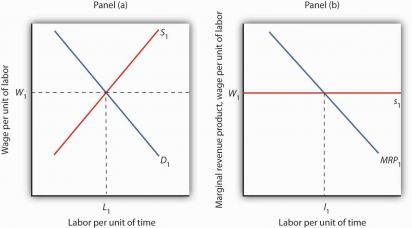Wage determination under free market forces
We have seen that a firm’s demand for labour depends on the marginal product of labour and the price of the good the firm produces.
We add the demand curves of individual firms to obtain the market demand curve for labour.
Supply in a particular market depends on variables such as worker preferences, the skills and training a job requires, and wages available in alternative occupations.
Wages are determined by the intersection of demand and supply.
The operation of labour markets in perfect competition is illustrated in Graphs (given below), “Wage Determination and Employment in Perfect Competition”. The wage W1 is determined by the intersection of demand and supply in Panel (a). Employment equals L1 units of labour per period. An individual firm takes that wage as given; it is the supply curve s1 facing the firm. This wage also equals the firm’s marginal factor cost. The firm hires l1 units of labour, a quantity determined by the intersection of its marginal revenue product curve for labour MRP1 and the supply curve s1. We use lowercase letters to show quantity for a single firm and uppercase letters to show quantity in the market.
Wage Determination and Employment in Perfect Competition

Wages in perfect competition are determined by the intersection of demand and supply in Panel (a). An individual firm takes the wage W1 as given. It faces a horizontal supply curve for labour at the market wage, as shown in Panel (b). This supply curve s1 is also the marginal factor cost curve for labour. The firm responds to the wage by employing l1 units of labour, a quantity determined by the intersection of its marginal revenue product curve MRP1 and its supply curve s1.





